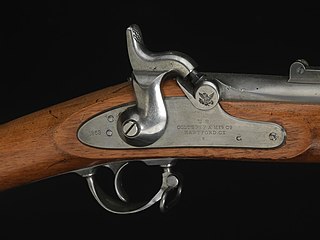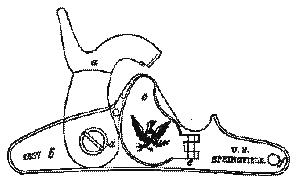
The Charleville musket was a .69 caliber standard French infantry musket used in the 18th and 19th centuries. It was made in 1717 and was last produced during the 1840s. However, it still saw limited use in conflicts through the mid-19th century.

The Springfield Model 1861 was a Minié-type rifled musket used by the United States Army during the American Civil War. Commonly referred to as the "Springfield". It was the most widely used Union Army shoulder weapon during the Civil War, favored for its range, accuracy, and reliability.
A rifled musket, rifle musket, or rifle-musket is a type of firearm made in the mid-19th century. Originally the term referred only to muskets that had been produced as a smoothbore weapon and later had their barrels replaced with rifled barrels. The term later included rifles that directly replaced, and were of the same design overall as, a particular model of smoothbore musket.

The musketoon is a shorter-barrelled version of the musket and served in the roles of a shotgun or carbine. Musketoons could be of the same caliber as the issue musket or of a much larger caliber, 1.0–2.5 inches (25–63 mm). The musketoon is most commonly associated with naval use, and pirates in particular, though they also served in a carbine role with cavalry. Musketoon barrels were often flared at the muzzle, resembling a cannon or blunderbuss.

The M1819 Hall rifle was a single-shot breech-loading rifle designed by John Hancock Hall, patented on May 21, 1811, and adopted by the U.S. Army in 1819. It was preceded by the Harpers Ferry M1803. It used a pivoting chamber breech design and was made with either flintlock or percussion cap ignition systems. The years of production were from the 1820s to the 1840s at the Harpers Ferry Arsenal. This was the first breech-loading rifle to be adopted in large numbers by any nation's army, but not the first breech-loading military rifle – the Ferguson rifle was used briefly by the British Army in the American Revolutionary War. The Hall rifle remained overshadowed by common muskets and muzzleloading rifles which were still prevalent until the Civil War. The early flintlocks were mostly converted to percussion ignition.

The origins of the modern British military rifle are within its predecessor the Brown Bess musket. While a musket was largely inaccurate over 100 yards (91 m), due to a lack of rifling and a generous tolerance to allow for muzzle-loading, it was cheap to produce and could be loaded quickly. The use of volley or mass firing by troops meant that the rate of fire took precedence over accuracy.

The Springfield Model 1816 was a .69 caliber flintlock musket manufactured in the United States during the early 19th century.

The Springfield Model 1822 was a .69 caliber flintlock musket manufactured by the United States in the early 19th century.
The Springfield Model 1812 Musket is a .69 caliber, flintlock musket manufactured by the Springfield Armory.

The Enfield Pattern 1853 rifle-musket was a .577 calibre Minié-type muzzle-loading rifled musket, used by the British Empire from 1853 to 1867; after which many were replaced in service by the cartridge-loaded Snider–Enfield rifle.

The Springfield Model 1868 was one of the rifles which used the trapdoor breechblock design developed by Erskine S. Allin.
The M1841 Mississippi rifle is a muzzle-loading percussion rifle used in the Mexican–American War and the American Civil War.

The Richmond rifle was a rifled musket produced by the Richmond Armory in Richmond, Virginia, for use by the Confederate States Army during the American Civil War.
During the American Civil War, an assortment of small arms found their way onto the battlefield. Though the muzzleloader percussion cap rifled musket was the most numerous weapon, being standard issue for the Union and Confederate armies, many other firearms, ranging from the single-shot breech-loading Sharps and Burnside rifles to the Spencer and the Henry rifles - two of the world's first repeating rifles - were issued by the hundreds of thousands, mostly by the Union. The Civil War brought many advances in firearms technology, most notably the widespread use of rifled barrels.
Springfield musket may refer to any one of several types of small arms produced by the Springfield Armory in Springfield, Massachusetts, for the United States armed forces. In modern times, these muskets are commonly referred to by their date of design followed by the name Springfield. However, U.S. Ordnance Department documentation at the time did not use "Springfield" in the name.

The US Model 1842 Musket was a .69 caliber musket manufactured and used in the United States during the 19th century. It is a continuation of the Model 1816 line of muskets but is generally referred to as its own model number rather than just a variant of the Model 1816.

The Springfield Model 1855 was a rifled musket widely used in the American Civil War. It exploited the advantages of the new conical Minié ball, which could be deadly at over 1,000 yards (910 m). It was a standard infantry weapon for Union and Confederates alike, until the Springfield Model 1861 supplanted it, obviating the use of the insufficiently weather resistant Maynard tape primer.
The Potzdam musket was the standard infantry weapon of the Royal Prussian Army from the 18th century until the military reforms of the 1840s. Four models were produced—in 1723, 1740, 1809 and 1831.











